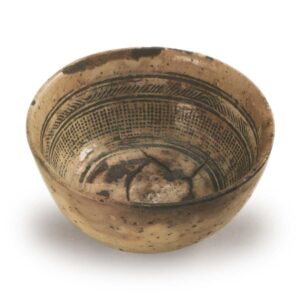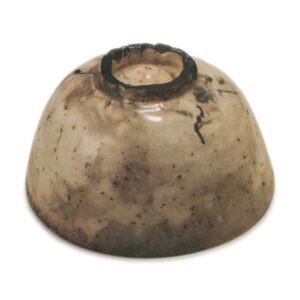

Height: 6.8-7.1cm
Diameter: 13.3-13.8cm
Outer diameter of foot ring: 4.8-5.0cm
Height of foot ring: 0.8-0.9cm
This tea bowl is somewhat different from the so-called Kosan-shima. Some people call it “Kohiki-mishima” because the outside is Kohiki and the inside is Rikate. The name Ryogoku is also thought to have been given because of these two characteristics.
Mishima is a representative pottery of the early Yi Dynasty, and was produced widely throughout southern Korea, but the number of Mishima pieces that have survived is extremely small compared to the number of Mishima pieces that have been excavated from Korea in recent years. Of these, the relatively large number of old Mishima ware is produced in a variety of places, and some are thought to be from Gyeongsangnam-do, while others are thought to be from Goryeong in Gyeongsangbuk-do or Gyeryongsan in Chungcheongnam-do. However, even though they are called Kosando, they are not necessarily older than the Yebinje, Hwasando, or Daesando. In fact, some of them are thought to be newer than the Yebinje. In any case, it is thought that the production of Kosando in southern Korea ended with the Japanese invasion of Korea.
This bowl has a round shape and a gentle appearance, but when you look at the inside, you are surprised by the rough landscape. The rim is slightly convex and thick, and there are several places where the glaze is peeling off in a moth-eaten pattern. On the inside, there is a single diagonal line pattern near the rim, and below that, a fine calendar pattern runs all the way to the bottom in a relatively clear and strong manner. The tea pool is wide and large. In addition, there is a large crack running in all directions in the center, and there are about six places where the marks of the overglaze firing can be counted. In addition, there are purple-tinged stains and loose glaze, creating a magnificent scene that is hard to describe.
The exterior surface is a so-called powder-coated white finish, and on this white surface, light brown stains spread out like a cloud. In addition, there are also holes scattered all over the surface, cracks that appear as if fruit is ripening and bursting open around the rounded waist, and places where the blue of the glaze can be seen through the white, like a glimpse of the blue sky through the clouds, so the scenery on the outside is just as rich as the inside.
The foot ring also has a slightly different style. It is somewhat small, but it is attached to the body so that it seems to sink into it, and on the tatami mat there are several places where intense cracks have formed due to the round, layered clay being bitten off. There is no clay inside the foot, and the center of the foot shows the whorl pattern of the potter’s wheel. It is a small but strong and elegant foot.
Among the relatively large and flat tea bowls of Mishima, this tea bowl is truly rare in that it is both excellent in shape and glaze color, and also has a variety of changes inside and out.
It was originally owned by the Mitsui family, and later came into the possession of the Himeji Sakai family, and is recorded in the Himeji Sakai Kura-cho (Himeji Sakai Storehouse Account Book) as a famous old Mishima tea bowl. The inner box is black lacquered. The gold-painted characters on the lid are said to be by Kobori Gunjuro, but this is not certain.



